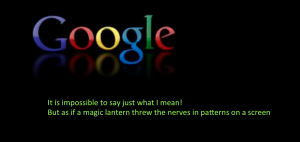 Fixation: The fixing process is important to me theoretically because it’s a cross cutting term. Fixing suggests that capture is not just a matter of direct representation but of representation in a particular way. So, in so much as platforms, or networks of platforms, capture and fix, they do so with a certain plan. In as much as they afford users the ability to do a number of things and they capture a host of content, fixing processes frame the content in particular ways. Formats, character limits, filters, etc. are the most evident elements of fixing but so are things such as the arrangements of content on a platform’s interface, the exclusion of content and the platform’s triangulation of its fixing processes with laws, norms and business goals. I like the work that’s being done to interrogate fixation by our colleagues around the globe. The work on interrogating normativity, neoliberal ideologies in digital architectures, big data, social practice and the politics of algorithms is an empirically diverse and theoretically rich sortie into the messy world of fixation.
Fixation: The fixing process is important to me theoretically because it’s a cross cutting term. Fixing suggests that capture is not just a matter of direct representation but of representation in a particular way. So, in so much as platforms, or networks of platforms, capture and fix, they do so with a certain plan. In as much as they afford users the ability to do a number of things and they capture a host of content, fixing processes frame the content in particular ways. Formats, character limits, filters, etc. are the most evident elements of fixing but so are things such as the arrangements of content on a platform’s interface, the exclusion of content and the platform’s triangulation of its fixing processes with laws, norms and business goals. I like the work that’s being done to interrogate fixation by our colleagues around the globe. The work on interrogating normativity, neoliberal ideologies in digital architectures, big data, social practice and the politics of algorithms is an empirically diverse and theoretically rich sortie into the messy world of fixation.
 For me there are some things that remain to be explored of the fixation process. Estrangement from ourselves for one thing is not often discussed. We, sometimes rightly, celebrate the opportunities social media afford us to represent ourselves, the selves we want to be, or to connect but often forget about the odd moments when we see that captured self, fixed in platform and then turning toward the screen, should say: “That is not it at all, That is not what I meant, at all.” Maybe we’ve all had that feeling when, for example, Facebook implemented the timeline feature. It presented our history as a matter of data, a composite if tags (by us or of us), images, blurbs, etc. Captured into the platform or surrendered there by us our history, so mediated, was therefore not necessarily authored by us, a species of unauthorized biography. Of you history shall be written, but remember “history is always written by the winners.”
For me there are some things that remain to be explored of the fixation process. Estrangement from ourselves for one thing is not often discussed. We, sometimes rightly, celebrate the opportunities social media afford us to represent ourselves, the selves we want to be, or to connect but often forget about the odd moments when we see that captured self, fixed in platform and then turning toward the screen, should say: “That is not it at all, That is not what I meant, at all.” Maybe we’ve all had that feeling when, for example, Facebook implemented the timeline feature. It presented our history as a matter of data, a composite if tags (by us or of us), images, blurbs, etc. Captured into the platform or surrendered there by us our history, so mediated, was therefore not necessarily authored by us, a species of unauthorized biography. Of you history shall be written, but remember “history is always written by the winners.”
 Despite the dynamism of social media: of streams of text, constant updates, ever changing videos and images, fixation ensures a certain suspension of action. Related to what danah boyd calls “permanence,” but permanence may belie a certain kind of political economy and intent that wants to make capture a practice, not merely a consequence of a technical structure thrust upon us ex nihilo. “Networked publics,” yes, but also network products and networked markets. Fixation, in biology requires the use of chemical agents to create chemical bonds between amino acids across the proteins that are the composite of biological systems and thus stops in its tracks denaturation (decay and entropy) but also life. Fixation is the literal pinning-down of dynamic organic life so that it may be examined. Fixation through algorithm renders the social, the person or the group as object and process, harnessable for markets, for governments, for corporations. As T.S. Elliot once asked, “When I am pinned and wriggling on the wall, Then how should I begin. To spit out all the butt-ends of my days and ways?”
Despite the dynamism of social media: of streams of text, constant updates, ever changing videos and images, fixation ensures a certain suspension of action. Related to what danah boyd calls “permanence,” but permanence may belie a certain kind of political economy and intent that wants to make capture a practice, not merely a consequence of a technical structure thrust upon us ex nihilo. “Networked publics,” yes, but also network products and networked markets. Fixation, in biology requires the use of chemical agents to create chemical bonds between amino acids across the proteins that are the composite of biological systems and thus stops in its tracks denaturation (decay and entropy) but also life. Fixation is the literal pinning-down of dynamic organic life so that it may be examined. Fixation through algorithm renders the social, the person or the group as object and process, harnessable for markets, for governments, for corporations. As T.S. Elliot once asked, “When I am pinned and wriggling on the wall, Then how should I begin. To spit out all the butt-ends of my days and ways?”
There is a tension in fixation: Fixed slices of time and life matter as reducible data sets but on the other hand, the system must be plastic enough to accommodate new data sets like status updates on the status update on you. System plasticity (a term used in neurobiology to describe dynamic neuronal architecture) in this case represents a conversation between the dynamic nature of human and the more bounded nature of data. A conversation between the evolving, the living, the dying and what we are as data in the network: a fixed point. Ultimately, decisions made based on bounded data endure beyond the instant and impact already changed circumstances. A data isomorph Lewis Mumford would be frightened by I imagine. Herein then we may find room for resistance, in the lag between the fixed and the living where the cacophany of human noise, randomness and messiness will hopefully confound the platform’s algorithm. And it will be left, at last, only with impressions.
Conversion: Fixation sets up the context for conversion, the transformation of all the is known, all that is fixed into elements of exchange economies. It creates the political-economy of participation; of creativity; and of the self as cultural product. For designers of capture platforms, conversion is a technological problem as much as it is a social question. My point here is that at the user level social processes fixed in social media afford an understanding of “what is going on.” They translate for users a reality of place, time, outcomes and possibilities. Capture platforms make concrete and argue for their version of meaning and value through design. For platform designers, the trick is  conveying value in a way that is both socially perceived and procedurally acceptable by a user base. For users, technical solutions provided by platforms take the shape of feedback systems. Communication features that allow users to respond to one another’s participation. Not simply to say something back, mind you, but to perform a narrative by deploying a literacy in images, texts and sound creatively assembled on spaces laid out by architecture. Extant research has taught us a lot about the social dynamics afforded within these systems. Economies of popularity, of tribe, of identity, are all there at play like the flying parts of a mad Corliss engine. But feedback systems do more then ensure social process, they reify it.
conveying value in a way that is both socially perceived and procedurally acceptable by a user base. For users, technical solutions provided by platforms take the shape of feedback systems. Communication features that allow users to respond to one another’s participation. Not simply to say something back, mind you, but to perform a narrative by deploying a literacy in images, texts and sound creatively assembled on spaces laid out by architecture. Extant research has taught us a lot about the social dynamics afforded within these systems. Economies of popularity, of tribe, of identity, are all there at play like the flying parts of a mad Corliss engine. But feedback systems do more then ensure social process, they reify it.
 To reify: To make real or concrete that which was abstract. In their reification function, feedback systems make visible and record the social. They literally allow users to see strife, reciprocity, attention economies, popularity, etc. Not only that but, the reification function creates the architecture by which value can be derived from those processes. It becomes the material proof of what may be the case outside the platform, thus adding to already existing social capital, status, meaning or popularity. Conversely, they may create a platform-based referent that validates perceptions of value external to the platform. To make this point more concrete think of something as everyday as popularity and the person who has it, at school or at work. If he or she is able to import it into the platform, reifying it through a feedback system, then it’s possible that it may increase within the platform but also outside it. For someone without much popularity, who then is able to build it within platform, creating what Alice Marwick and others might call “micro celebrity,” it may well translated to external consequences. The platform in that case, serves as a form of social proof. But it can also serve as an amplifier of already existing conditions.
To reify: To make real or concrete that which was abstract. In their reification function, feedback systems make visible and record the social. They literally allow users to see strife, reciprocity, attention economies, popularity, etc. Not only that but, the reification function creates the architecture by which value can be derived from those processes. It becomes the material proof of what may be the case outside the platform, thus adding to already existing social capital, status, meaning or popularity. Conversely, they may create a platform-based referent that validates perceptions of value external to the platform. To make this point more concrete think of something as everyday as popularity and the person who has it, at school or at work. If he or she is able to import it into the platform, reifying it through a feedback system, then it’s possible that it may increase within the platform but also outside it. For someone without much popularity, who then is able to build it within platform, creating what Alice Marwick and others might call “micro celebrity,” it may well translated to external consequences. The platform in that case, serves as a form of social proof. But it can also serve as an amplifier of already existing conditions.
Conversion through feedback also creates an architecture for reciprocity, trust, performance, participation, alliances, etc. Conversion and its methods are technological solutions to the accounting of social dynamics and their performance. By creating ways in which users can see, read, hear and feel the social and by creating architectures by which those inputs can be responded to, they convert participation into value, situated value for the user and ad revenue for the platform owners.

 What you see in the image above is YouTube justice, an example of reification from my research that illustrates a social, community driven and understood value. The user [12awinstinct] was accused of stealing content from another user [iFlyILLINI]. The community through a review of evidence (videos and supporting commentary from other users) found him guilty and punished him with a loss of subscribers, a potentially costly tax on social and monetary capital if ad revenue was involved. Conversely the community rewarded the offended user with an explosion of subscribers. Perhaps most importantly, the process was logged in real time by systems inside the platform but also by 3rd party aggregators like one which tracks channel popularity on YouTube. The vested elements of the YouTube community saw justice done, YouTube justice.
What you see in the image above is YouTube justice, an example of reification from my research that illustrates a social, community driven and understood value. The user [12awinstinct] was accused of stealing content from another user [iFlyILLINI]. The community through a review of evidence (videos and supporting commentary from other users) found him guilty and punished him with a loss of subscribers, a potentially costly tax on social and monetary capital if ad revenue was involved. Conversely the community rewarded the offended user with an explosion of subscribers. Perhaps most importantly, the process was logged in real time by systems inside the platform but also by 3rd party aggregators like one which tracks channel popularity on YouTube. The vested elements of the YouTube community saw justice done, YouTube justice.
 By now it should come as no surprise that value “lives” on multiple levels in a platform. So in my example the platform allowed YouTube users to derive situated value from the conversion of subscriber numbers into justice or retribution. On another level, platform owners will need to do some conversion of their own, albeit primarily in terms of revenue. For social network businesses bent on the “social” or “the socially created” as their central value driver, inventory (you, me and our interactions and creations) must be parsed by mechanisms that allow us and ours to be sold. These mechanisms usually take the shape of systems that analyze and repackage. Typically these are back-end structures, hidden from user view. Ultimately however, the market value of a social media web business hinges on the algorithms that analyze and repackage both content and creators in ways that can be traded. Facebook’s less than stellar IPO, for example, was not only the result of glitches in the NASDAQ’s trading system but also perhaps due to a general uncertainty about how exactly Facebook was going to convert all those users and their participation (i.g. their likes, links, comments, pictures, personal information, and who knows what else) into profit.
By now it should come as no surprise that value “lives” on multiple levels in a platform. So in my example the platform allowed YouTube users to derive situated value from the conversion of subscriber numbers into justice or retribution. On another level, platform owners will need to do some conversion of their own, albeit primarily in terms of revenue. For social network businesses bent on the “social” or “the socially created” as their central value driver, inventory (you, me and our interactions and creations) must be parsed by mechanisms that allow us and ours to be sold. These mechanisms usually take the shape of systems that analyze and repackage. Typically these are back-end structures, hidden from user view. Ultimately however, the market value of a social media web business hinges on the algorithms that analyze and repackage both content and creators in ways that can be traded. Facebook’s less than stellar IPO, for example, was not only the result of glitches in the NASDAQ’s trading system but also perhaps due to a general uncertainty about how exactly Facebook was going to convert all those users and their participation (i.g. their likes, links, comments, pictures, personal information, and who knows what else) into profit.
Generating value for a social media business is both a technical and social problem. Technically the “right” algorithms must be designed to execute analysis and aggregation that will suit costumers. As a social problem markets must be created and sustained, labor forces kept working and incentivized, people must see the situated value of their products through conversion so that they keep doing it, so that the platform can do its other forms of conversion. Yes, as Tarleton Gillespie would say, algorithms have a socially contingent nature that impacts the way in which they “speak” about what is valuable. If thinking about the values embedded in algorithms allows us to see their politics, it may also benefit us to think of their economics not only as a value but as a logic for understanding what is the case.
What an algorithm says about a group, individual, or any bit of information on a platform is concerned with value (both in the long and short term). The algorithm may suggest a “trend” as Twitter does but as it constructs a trend it also builds value. Trending, as a measurable process, is an exercise in some form of measurement (public opinion, popularity, rate of increasing or decreasing interest) but it’s also a stab at creating value. It’s an attempt to convert all that “chatter” into something that can be sold, to investors, to other media businesses, and to users. The interesting thing is that the more one considers what an algorithm is telling us, the more one realizes that, for some platforms, “trending” of any sort (on twitter or YouTube) is a sure bet.
This is not to suggest that outputs are necessarily biased toward what amounts to the most profitable analysis or aggregation but rather that the process of analysis and aggregation and its claims to truthfulness about whatever information was processed is done in the first place because it is perceived to be valuable. No one would have asked is it trending? Unless some one else had first asked, “can we sell trending?” The value placed on the outcome of an algorithm is as much based on its “accuracy” as it is on 1) having users see it as accurate and 2) when users are inventory in that platform, having them handed over as seers of information of a particular stripe.
 Because economic value is part of the equation, our social processes, our identities and our membership in family, work, etc. become functional artifacts, means to ends for the platform and their owners. As such we become mass culture and the platform the production apparatus. Our profiles are made by us but with tools not of our making. Our Google search results may be crowd-made but made in the image reflected in platform and its triangulations of what counts as valuable, useful and interesting. The skepticism of science and technology studies that questions, at its core, any socially situated technical or scientific system that claims to know the case, should be brought to bear on such artifice. Power lurks in epistemology. I have to say algorithm and platform are more than political or, as they like to tells us, stewards of public discourse. They are epistemology.
Because economic value is part of the equation, our social processes, our identities and our membership in family, work, etc. become functional artifacts, means to ends for the platform and their owners. As such we become mass culture and the platform the production apparatus. Our profiles are made by us but with tools not of our making. Our Google search results may be crowd-made but made in the image reflected in platform and its triangulations of what counts as valuable, useful and interesting. The skepticism of science and technology studies that questions, at its core, any socially situated technical or scientific system that claims to know the case, should be brought to bear on such artifice. Power lurks in epistemology. I have to say algorithm and platform are more than political or, as they like to tells us, stewards of public discourse. They are epistemology.
 To the extent that social media capture (recruit, fix and convert) they do so in a manner that reproduces and reinforces a type of cultural production, a particular type of self (networked as Julie Cohen would say), configured by fixation for conversion. The broader point is that once in place, that system continues to reinforce those arrangements, begging them of their users and leaking those practices to life worlds outside the realm of media. At such points social processes removed from social media are confronted with arrangements born in the ether. We assume connectivity and feel displaced without it. We are habitually never alone, we are the “searching for network” function and have become accustomed to being reified and captured. Say what you may, the structure of how we are socially has changed in many respects since we started liking, status updating, taking selfies and tweeting. We may have made some facets of social media our own, through adaptation and appropriation of features and alternative uses, but capture/conversion systems care little of that. It’s all part of the bet, that, in the processes of digital cultural production, through capture everyone and anyone can be pinned and sold to somebody.
To the extent that social media capture (recruit, fix and convert) they do so in a manner that reproduces and reinforces a type of cultural production, a particular type of self (networked as Julie Cohen would say), configured by fixation for conversion. The broader point is that once in place, that system continues to reinforce those arrangements, begging them of their users and leaking those practices to life worlds outside the realm of media. At such points social processes removed from social media are confronted with arrangements born in the ether. We assume connectivity and feel displaced without it. We are habitually never alone, we are the “searching for network” function and have become accustomed to being reified and captured. Say what you may, the structure of how we are socially has changed in many respects since we started liking, status updating, taking selfies and tweeting. We may have made some facets of social media our own, through adaptation and appropriation of features and alternative uses, but capture/conversion systems care little of that. It’s all part of the bet, that, in the processes of digital cultural production, through capture everyone and anyone can be pinned and sold to somebody.
_________
Acknowledgements: This series of posts is based on a lecture given at the Colloquium for MIT’s Comparative Media Studies Program in the fall of 2012. My thanks to MIT’s CMS for inviting me and for asking me to think on this topic. Of course thank you TS Elliot and the Wachowskis 🙂 I would also like to thank all of the contributors and participants in Culture Digitally. Friends, all. Without their writing, conversations and joking around over beer or a nice cup of coffee at a conference or workshop my thinking on these matters would not be possible. If you are not listed on the blog but we have spoken and shared a laugh and an idea, you are in here too.


